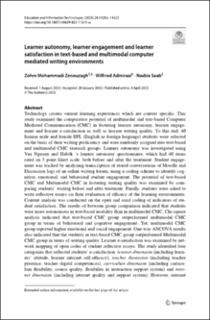| dc.contributor.author | Zenouzagh Mohammadi, Zohre | |
| dc.contributor.author | Admiraal, Wilfried | |
| dc.contributor.author | Saab, Nadira | |
| dc.date.accessioned | 2023-12-04T06:49:38Z | |
| dc.date.available | 2023-12-04T06:49:38Z | |
| dc.date.created | 2023-04-18T18:25:48Z | |
| dc.date.issued | 2023 | |
| dc.identifier.citation | Education and Information Technologies : Official Journal of the IFIP technical committee on Education. 2023, 28 14283-14323. | en_US |
| dc.identifier.issn | 1360-2357 | |
| dc.identifier.uri | https://hdl.handle.net/11250/3105672 | |
| dc.description.abstract | Technology creates variant learning experiences which are context specific. This
study examined the comparative potential of multimodal and text-based Computer
Mediated Communication (CMC) in fostering learner autonomy, learner engage-
ment and learner e-satisfaction as well as learner writing quality. To this end, 40
Iranian male and female EFL (English as foreign language) students were selected
on the basis of their writing proficiency and were randomly assigned into text-based
and multimodal CMC research groups. Learner autonomy was investigated using
Van Nguyen and Habók ‘s learner autonomy questionnaire, which had 40 items
rated on 5 point likert scale, both before and after the treatment. Student engage-
ment was tracked by analyzing transcription of stored conversations of Moodle and
Discussion logs of an online writing forum, using a coding scheme to identify cog-
nitive, emotional, and behavioral student engagement. The potential of text-based
CMC and Multimodal CMC in fostering writing quality was examined by com-
paring students’ writing before and after treatment. Finally, students were asked to
write reflective essays on their evaluation of efficacy of the learning environments.
Content analysis was conducted on the open and axial coding of indicators of stu-
dent satisfaction. The results of between group comparison indicated that students
were more autonomous in text-based modality than in multimodal CMC. Chi-square
analysis indicated that text-based CMC group outperformed multimodal CMC
group in terms of behavioral and cognitive engagement. Yet, multimodal CMC
group reported higher emotional and social engagement. One-way ANCOVA results
also indicated that the students in text-based CMC group outperformed Multimodal
CMC group in terms of writing quality. Learner e-satisfaction was examined by net-
work mapping of open codes of student reflective essays. The study identified four
categories that reflected students’ e-satisfaction: learner dimension (including learn-
ers’ attitude, learner internet self-efficacy), teacher dimension (including teacher
presence, teacher digital competences), curriculum dimension (including curricu-
lum flexibility, course quality, flexibility in interaction support system) and inter-
net dimension (including internet quality and support system). However, internet dimension received negative judgments from both groups. The implications of the
study and suggestions for further research are discussed. | en_US |
| dc.language.iso | eng | en_US |
| dc.rights | Navngivelse 4.0 Internasjonal | * |
| dc.rights.uri | http://creativecommons.org/licenses/by/4.0/deed.no | * |
| dc.title | Learner autonomy, learner engagement and learner satisfaction in text-based and multimodal computer mediated writing environments | en_US |
| dc.type | Peer reviewed | en_US |
| dc.type | Journal article | en_US |
| dc.description.version | publishedVersion | en_US |
| cristin.ispublished | true | |
| cristin.fulltext | original | |
| cristin.qualitycode | 1 | |
| dc.identifier.doi | 10.1007/s10639-023-11615-w | |
| dc.identifier.cristin | 2141683 | |
| dc.source.journal | Education and Information Technologies : Official Journal of the IFIP technical committee on Education | en_US |
| dc.source.volume | 28 | en_US |
| dc.source.pagenumber | 14283-14323 | en_US |

